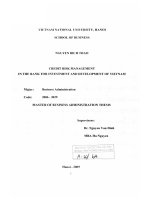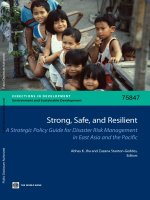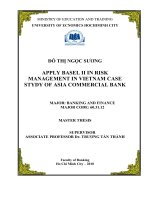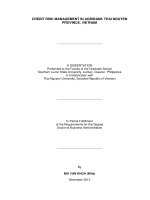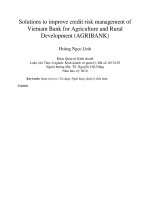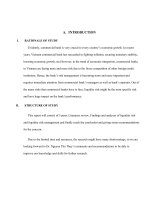CREDIT RISK MANAGEMENT IN VIETNAM TECHNOLOGY AND COMMERCIAL JOINT STOCK BANK
Bạn đang xem bản rút gọn của tài liệu. Xem và tải ngay bản đầy đủ của tài liệu tại đây (1.05 MB, 106 trang )
NATIONAL ECONOMIC UNIVERSITY
NEU BUSINESS SCHOOL
VU HUYEN HAI
CREDIT RISK MANAGEMENT IN VIETNAM TECHNOLOGY
AND COMMERCIAL JOINT STOCK BANK
MASTER OF BUSINESS ADMINISTRATION THESIS
Ha Noi – 2021
NATIONAL ECONOMICS UNIVERSITY
NEU BUSINESS SCHOOL
VU HUYEN HAI
CREDIT RISK MANAGEMENT IN VIETNAM TECHNOLOGY
AND COMMERCIAL JOINT STOCK BANK
MASTER OF BUSINESS ADMINISTRATION THESIS
SUPERVISOR: DR. TRAN THI MINH HUONG
Vũ Huyền Hải – EMBA18005
HANOI –2021
Vũ Huyền Hải – EMBA18005
TABLE OF CONTENTS
Vũ Huyền Hải – EMBA18005
ACKNOWLEDGEMENTS
This work would not have been possible without the support of the National
Economic University. I am especially indebted to Dr. Tran Thi Minh Huong, who
has been supportive of my thesis and who worked actively to provide me with the
protected academic time to pursue those goals. She always gives me invaluable
advice, continuous support, and patience during my study. Her immense knowledge
and plentiful experience have encouraged me in all the time of my academic
research.
I would like to express sincere thanks to family, friends, my colleagues at
Techcombank for their assistance, insightful comments, and suggestions at every
stage of the thesis.
I am looking forward to receiving your comments to improve this thesis.
Yours sincerely,
Hanoi, date…month… year 2021
Student
Vu Huyen Hai
Vũ Huyền Hải – EMBA18005
ABBREVIATION
ARCO: Audit and Risk Management Committee
BCDE: Business Credit Decision Engine
BB customers/SME customers: Small and medium-sized enterprises
BB division: Business Banking division/in charge of SME customer
management
BBC/Branch: Business Banking Center or Branches
CA - HO: Credit appraisal department – Head office.
CA manager: Credit appraisal manager - Risk management division
CA: Credit appraisal officer - Risk management division.
CASA: Current Account and Savings Account
CCA: Center of Credit Admin
CLV: Customer Lifetime Value
CSM: Credit Solution Management
CPM: Credit portfolio management
CRM: Credit risk management
EAD: Exposure at Default (EAD)
EL: Expected Loss
EWS: Early warning system
FMCG: Fast-moving consumer goods
HO: Head office of TCB
IFRS 9: International Financial Reporting Standard
LGD: Loss Given Default
NPL: Non-performing loan
Vũ Huyền Hải – EMBA18005
PD: Probability of Default
PFS: Personal Finance Service
RM: Relationship Manager/Credit officer
SBV: State Bank of Vietnam
TCB/Techcombank: Vietnam Technological and Commercial Joint Stock Bank
YoY: Year-over-year
WB customers: Wholesales customers
Vũ Huyền Hải – EMBA18005
LIST OF TABLES
Table
Page
Table 3.1 – The asset growth rate
36
Table 3.2 - Lending growth rate in recent 3 years
37
Table 3.3 – Profitability indicators
37
Table 3.4 – Target total outstanding of customer segmentation for 2021
40
Table 3.5 – Target estimated loss for 2021
40
Table 3.6 - Credit rating score at TCB
44
Table 3.7 – Credit limit of segmentation and industry
46
Table 3.8 - Loans structure by customer segmentation in recent 3 years
50
Table 3.9 –Loan structure by term loan
51
Table 3.10 - Loan structure by industry sectors
51
Table 3.11 – Loan classification in recent 3 years
52
Table 3.12 – Overdue and NPL in recent 3 years
53
Table 3.13 – Provisions in recent 3 years
53
Vũ Huyền Hải – EMBA18005
EXECUTIVE SUMMARY
Banking is the business of accepting risk. The primary objectives of any
commercial bank are to manage all the risks to make and maintain the profit for its
shareholders. The ongoing development of innovative risk management methods
has helped the banks easier to identify, measure, implement and treat potential
credit risks. This research proposal is intended to assist the reader to understand the
credit risk management process as well as capture the actual credit risk management
process in Techcombank and then assess its effectiveness.
The opening is the introductory part. It gives an idea about the research
objective, the scope, and the research methodology. The thesis has been segregated
into three separate chapters. Chapter 1 mentions the theoretical framework of credit
risk and credit risk management in commercial banks. Chapter 2 contains the
discussion of the actual implementation of credit risk management procedures in
Techcombank. Chapter 3 includes the findings and recommendations of the study.
Appendices are enclosed at the end to help the reader to gain a detailed idea
Vũ Huyền Hải – EMBA18005
1.1.
1.2.
CHAPTER 1 - INTRODUCTION
Rationale
Commercial banks have a critical role in keeping economies vibrant and
growing by lending to creditworthy borrowers. Lending helps the economy growth
by allowing businesses to buy new equipment, add workers, or sign contracts for
increased trade or services that help a stronger national economy. In a current
competitive environment, commercial banks provide a wide range of products and
services for their customers but their primary activities are still taking term deposits
and lending. Besides customer quality, credit risk management is undoubtedly one
of the most important issues in financial risk management
Credit risk in banks is always with the lending function. The ability to
separate good customers from bad customers is a very key factor to becoming a
successful player in the banking. Banks cannot avoid bad customers or bad debts
but can minimize their impacts with proper evaluation and controls. So, it is
important for Vietnam Technological and Commercial Joint Stock Bank to analyze,
identify the causes for major credit problems, and implement an effective risk
management system. By analyzing, comparing, and synthesizing statistics, the
author has chosen the issue: "Credit risk management in Vietnam Technology and
Commercial Joint Stock Bank” to contribute the practical solutions to maximize
credit returns while minimizing the risks.
Research Objective
Vũ Huyền Hải – EMBA18005
1.3.
1.4.
This research aims to (i) find out the most suitable theoretical framework on
credit risk management in the banking sector (ii) analyze the current status of credit
risk management activities at TCB and (iii) propose recommendations improve
credit risk management at TCB.
Research questions
● What are the major contents of Credit risk management in TCB?
● What is the current situation of credit risk management activities in
TCB?
● What needs to be done to strengthen the credit risk management in
TCB?
Research methodology
1.4.1.Research process
Vũ Huyền Hải – EMBA18005
Figure 1: Research process
Source: Drawn by author
1.4.2.Data collection
The author conducted the data collection from two sources: Primary data and
secondary data.
1.4.2.1. Secondary data
Vũ Huyền Hải – EMBA18005
1.5.
1.6.
Information was collected from statics data and documents of SBV, TCB
internal reports/documents and other scientific magazines, websites, and research
on the credit risks in banking sector.
1.4.2.2. Primary data
Primary data was collected from in-depth interviews. The researcher
discussed and interviewed 5 managers at the Head Office and Branch: Head of
Corporate Credit Risk Department, Senior Manager of Legal and Compliance
Control Department, Head of Credit Admin, Head of So Giao dich Branch, Head of
Dong Do branch to discuss the current status of TCB’s CRM and then propose
initiatives to improve the TCB credit risk management.
1.4.3.Data analysis
The author gathered secondary data and in-depth interviews with experts to
complete the research model. Besides, the author used synthesis, comparison,
detailed analysis to find solutions that improve TCB CRM.
Scope of research
Research Objects: Credit risk management in TCB.
● Geographical: TCB
● Timing: Data was collected from 31/12/2019- 30/6/2021.
● Bank’s reports from 2019-2021.
Thesis structure
Vũ Huyền Hải – EMBA18005
CHAPTER 1: THEORETICAL BACKGROUND ON CREDIT RISK
AND CREDIT RISK MANAGEMENT IN COMMERCIAL BANK
CHAPTER 2: THE SITUATION CREDIT RISK MANAGEMENT IN
TCB
CHAPTER 3: RECOMMENDATION TO IMPROVE CREDIT RISK
MANAGEMENT IN TCB
Vũ Huyền Hải – EMBA18005
CHAPTER 2 -THEORETICAL BACKGROUND
ON CREDIT RISK AND CREDIT RISK
MANAGEMENT IN COMMERCIAL BANK
Credit risk in commercial bank
Risk definition and classification in commercial bank
2.1.1.1. Risk definition
In the market economy, any business activity always has underlying risks.
The Bank industry is not an exceptional sector. Risk in banking is determined as
one part of financial risk. It is defined as the possibility of receiving lower
profitability than the expectations due to the negative impacts from internal and
external shock events. When the bank deals with higher risk, it will succeed in
achieving greater profits, David H. Pyle (1999), Bank Risk Management, financial
risk in the banking sector is defined as the exposure of a bank to an unforeseen and
unplanned loss from a loan, a project, or an investment. Banks are now strongly
aware of the importance of identifying and measuring risk and have great effort to
control and avoid them.
2.1.1.2. Risk classification in commercial bank
Banks are now facing new type of risks in daily activities. Risks are events
happening undesirable and interrupt unfavorably on banking, leading to loss of
bank’s assets and then reducing bank’s net profit than expected. Hennie van
Vũ Huyền Hải – EMBA18005
Greuning and Sonja Brajovic Bratanovic (2020), Analyzing Banking Risk, key risks
in banking include credit risk, currency risk, market risk, liquidity risk, and
operational risk.
Bank risks
Credit risk
Currency risk
Market risk
Liquidity risk
Operational risk
Figure 2. The major types of bank risks
Source: Hennie van Greuning and Sonja Brajovic Bratanovic (2020), Analyzing
Banking Risk
2.1.2.Credit risk in commercial bank
2.1.2.1. Credit Risk definition
Currently, there are different definitions of credit risk. Hennie van Greuning
and Sonja Brajovic Bratanovic (2020), Analyzing Banking Risk, xredit risk occurs
when a debtor or issuer of a financial institution, that can be an individual, company
or country, is unable to repay the principal, interest and other investment-related
cash flows as agreed in the signed credit contract. Credit risk can cause cash flow
problems and affect a bank’s liquidity. Basel Committee on Banking Supervision
(1999), Principles for the Management of Credit Risk, credit risk is defined as the
possibility that a borrower can not meet its obligations under agreed terms. Saunder
Vũ Huyền Hải – EMBA18005
& H. Lange (1996), Financial Institutions Management – A Modern, Perspective,
Credit risk is a potential loss when a bank grants credit to a customer but the income
cannot cover the payment amount or the cash flow comes later than the expected
time.
2.1.3.Credit risk classification
Andrew Kimber
(2003), Credit Risk: From Transaction to Portfolio
Management, credit risk can be divided into 2 types: Transaction risk or default risk
and Portfolio risk.
Credit
Credit risk
risk
Transaction
Transaction risk
risk
Default
Default Risk
Risk
Portfolio
Portfolio risk
risk
Downgrade
Downgrade Risk
Risk
Comprises
Comprises intrinsic
intrinsic
Concentration
Concentration risk
risk
Figure 3. Credit risk classification
Source: Andrew Kimber (2003), Credit Risk: From
Transaction to Portfolio Management
2.1.3.1. Transaction risk or credit default risk
Vũ Huyền Hải – EMBA18005
Default risk is the probability that a borrower fails to make full and timely
payments of principal and interest as agreed terms. The credit default risk comes
from all bank’s transactions such as loans, bonds, securities, and derivatives.
Downgrade risk: Risk ratings of issuers can be downgraded, thus resulting in
downgrade risk.
2.1.3.2. Portfolio risk
Portfolio risk is divided into 2 types: Comprises intrinsic and Concentration
risk (industry risk). Comprises intrinsic is derived from the unique and distinctive
internal factors and characteristics of each borrower or economic sector or field.
Basel Committee on Banking Supervision (1999), Principles for the Management
of Credit Risk, Concentration risk arises from same borrowers or same counterparty
or industry that causes large potential losses, threatens the bank's creditworthiness
and core operations or impacts bank’s risk portfolio.
2.1.4.Causes of credit risks
In a credit relationship, there are two parties involved, the lender and the
borrower. Credit risk arising from the business environment is called objective risk.
Allen N. Berger & Robert DeYoung (1997) Problem Loans and Cost Efficiency in
Commercial Bank, Forthcoming, loan quality problems may be caused by external
events, such as regional economic downturns, that make extra expenses to handle
the nonperforming loans and bring low-cost efficiency to the bank. Credit risk may
come from (i) changes in the natural environment such as natural disasters,
epidemics, storms, and floods (ii) competition among credit institutions that makes
Vũ Huyền Hải – EMBA18005
them ignore standards and conditions in lending, lack of attention to credit quality
(iii) inadequate support from the credit management system or (iv) Changes in
interest rates, exchange rates, inflation, price index increases, input materials
increase affecting business results of customers, financial difficulties lead to
inability to repay debts.
Risks arising from borrowers and lenders are called subjective risks. Allen N.
Berger & Robert DeYoung (1997) Problem Loans and Cost Efficiency in
Commercial Bank, Forthcoming, Journal of Banking and Finance, banks have poor
skills in credit scoring can choose ineffective loans or projects. If they lack of
competency in collateral appraisal or unable to monitor and control the borrowers
after lending, credit risk will occur. As a consequence, the banks may have
incomplete credit assessment with unfulfilled information when appraising and
making loan decisions that leads to subjective decision making; no supervision and
management after lending. Ineffective early warning system may lead to the
impossibility to restrict in time, inadequate monitoring. Credit risk can come from
staff with poor ethics and professional qualifications and so on.
From borrower side, the borrowers may use capital for the wrong purpose
compared to the original business plan. In some cases, they have no business
management capacity, investment management or they lose business because goods,
and services provided cannot be sold so that no cash flow returns and no money to
pay for the loan. Borrowers' weakness and immorality also cause losses for the
bank. If the bank detects it early, the risk will be prevented
Vũ Huyền Hải – EMBA18005
Credit risk management
Credit risk management definition
Christopher L. Culp (2001), The Risk Management Process: Business
Strategy and Tactics, Credit risk management (CRM) can be defined as the process
by which risks are identified, measured and monitored with the intend to ensure that
they are fully understood and are in accepted limits and approved framework. David
H. Pyle (1999), Bank Risk Management, CRM is the practice of understanding and
mitigating losses in banks.
The objectives of credit risk management
Brian Coyle (2000), Framework for Credit Risk Management, the objectives
of credit management can be stated as safeguarding the company’s investment in
debtors and optimizing operational cash flows. Policies and procedures must be
applied for granting credit to customers, collecting payment, and limiting the risks
of non-payment. Paul Hopkin (2018), Fundamentals of Risk Management:
Understanding, Evaluating and Implementing Effective Risk Management: The
main goals of CRM are ensuring the stability of profitability, maintaining a constant
growth rate, and maximizing the bank value. Nowadays, commercial banks must
operate in unstable market conditions, the risk of constantly increasing Credit risk
management has the objective of ensuring the efficiency of credit activities and
continuously improving the quality of credit activities of commercial banks.
Vũ Huyền Hải – EMBA18005
Specifically, good credit risk management supports commercial banks to lower
credit risks and improve business safety.
Roles of credit risk management in commercial bank
When credit risk arises, it causes serious harm to the banks, to borrowers and
to the economy. Commercial banks will increase the bad debt portfolio, increase
provisioning, reduce lending so that reduce strength of the bank. Bad debts stop
borrower to lend money from banks, loss of business opportunities and face the risk
of bankruptcy. For the social economy, it makes production and circulation of goods
slow down, and the function as a tool to regulate the economy will be weakened.
Depositors' interests will not be guaranteed.
Credit risk management contents in commercial banks
Credit risk management process
Christopher L. Culp (2001), The Risk Management Process: Business
Strategy and Tactics, Credit risk management process can be presented by 1 circle
with these 3 following steps:
Vũ Huyền Hải – EMBA18005
Identification
Mornitor
Measurement
Figure 4. Credit risk management process
Source: Christopher L. Culp (2001), The Risk Management Process:
Business Strategy and Tactics
2.3.1.1.
Identification
Christopher L. Culp (2001), The Risk Management Process: Business
Strategy and Tactics, while identifying the CRM, there are two dimensions should
be concerned, by category of the obligor (can be called portfolio level) or by
specific obligor (defined as customer level). Therefore, any analysis and decision
can be undertaken, the commercial bank should find all the potential risks involved
by analyzing the sources of risks on two sides:
On the bank's side (category of obligor) At the whole portfolio level,
commercial banks often identify through macroeconomic assessment, economic
cycle, seasonal trends of the market, market share, and market supply and demand
Vũ Huyền Hải – EMBA18005
to develop business strategies. business, identify target customers through credit
orientation in each period. Credit orientation must be built aligned with the
approved risk appetite and credit limit. Banks can earlier identify credit risks by
analyzing the bank's credit portfolio on credit size, credit structure, industry,
currency...
On the customer’s sign (by specific obligator): When customers have signs
of potential risks, banks need to recognize the possibility of risks to respond
promptly.
Credit risk identification can be known while evaluating the signs related to
the relationship with the bank: The customer’s account balance unexpectedly
decreased; customers abnormally increase number or amount of loan requests, agree
at high-interest rates, the lending value is more than expected needs. In some cases,
an unusual delay when being asked to provide financial statements or avoiding
meeting with credit officers. A later sign is they have overdue principal and interest
or request to extend loan tenor. In post-disbursement visits, credit officers find they
used the money for wrong purposes or take the short-term debt to invest in mediumlong-term assets.
Commercial banks must analyze the financial situation: e.g.: Balance sheet
abnormally reduced cash balance, payables decrease, receivables increase or there
was a decrease in charter capital, sales increased but reduced profit or loss;
Profitability target decreased. Share price decreased, financial leverage increased.;
The quality of products and services decreases, losing credibility in the market,
customers, and sponsors; Unusual change in depreciation; owed to employees, the
Vũ Huyền Hải – EMBA18005
value of inventory increased abnormally; Reliance on unusual products to make a
profit; difficulty explaining the loan.
Bank can access the group of signs related to the management situation to
check whether the alarming signs: The governance or executive board structure
changes frequently; There is no cooperation or dispute in the executive board;
Regularly change senior officials and key staff or Unreasonable management costs.
Group of signs belonging to commercial matters includes: Change market name:
Exchange rate, interest rate, change tastes, new technology, new competitors.
Changes from State policy: Tax policy, establishment conditions, and environmental
activities; Reducing or cutting maintenance costs; Difficulty in product and service
development; Production and business location is changed.
Credit risk identification is the process of continuously and systematically
identifying possible problems and taking proactive measures to help reduce the loss
to a minimum.
2.3.1.2.
Risk measurement
Commercial banks conduct credit risk measurement using different
methods/models/techniques including quantitative and qualitative assessments and
assumptions. Risk measurement methods/models/techniques should be periodically
checked for their accuracy. Banks normally use both qualitative and quantitative
criteria. Anthony Saunders & Linda Allen (2002), Credit Risk Measurement New
Approaches to Value at Risk and Other Paradigms, for qualitative, they can use the
“Five C’s of Credit” measurement, in which, the bank will access 5 aspects:
Character, Capacity, Conditions, Capital, and Collateral.
Vũ Huyền Hải – EMBA18005
● Character: One of the important characteristics that banks value is that the
borrower must be honest and have integrity. The bank needs to trust that the
business is legally recognized, has the necessary competence and experience
to operate it successfully. In addition, the bank will check the business credit
history to make sure the borrower has a good reputation for repayment.
● Capacity (Cash Flow): The bank needs to assess whether the business can
repay the loan; sufficient cash flow to cover operating expenses and debts.
This is an indicator of a borrower's creditworthiness.
● Conditions: The bank will need to clearly understand the purpose of the
loan; they will want to know how the loan amount will be used - working
capital or renovation, new equipment investment, etc.
● Capital: Banks often require businesses to put up an amount of their capital
to make sure that the business is responsible for its investment.
● Collateral: The bank will consider collateral as a source of debt repayment
when the business is no longer able to repay the debt.
Quantitative criteria: Christopher L. Culp (2001), The Risk Management
Process: Business Strategy and Tactics, popular sources of internal ratings are credit
scoring models. It scores the creditworthiness of borrowers based on observable
variables and historical data. Commercial banks normally measure credit risk
through their internal credit rating system to ensure timely and accurate credit risk
monitoring and control. Credit rating is the assessment of the creditworthiness and
repayment ability of the borrower (current and future) through the credit rating
Vũ Huyền Hải – EMBA18005

